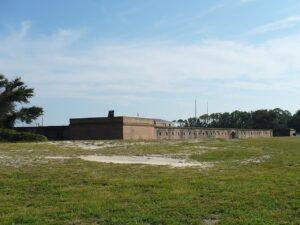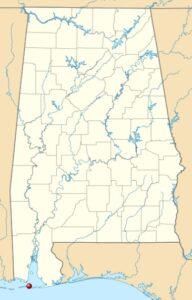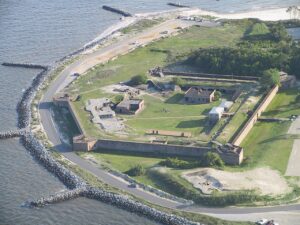 I love old military sites, like forts, and from one to another, they are so many differences. In Casper, Wyoming, where I live, Fort Caspar is a typical Old West fort as you would expect of the days of wagon trains and Indian rampages, but when you look at a fort back east and especially along coastal waters, where it would be necessary to protect our borders, they are much more military looking. Fort Gaines, located the eastern tip of Dauphin Island, off the Gulf coast of Alabama, is a very different looking fort, as my mind pictures forts anyway. Fort Gaines’ well-preserved ramparts, which have guarded the entrance to Mobile Bay for more than 150 years, look very much like they did when they were first built there. The structure is considered one of the nation’s best-preserved Civil War era masonry forts. However, it is also under threat from erosion, as is common of very old structures. The present Fort Gaines was initially designed in 1818 as the identical twin to Fort Morgan, which stands across Mobile Bay, to defend the new territory of Alabama. It was named for General Edmund Pendleton Gaines, a hero of the War of 1812. However, when Congress cancelled funding in 1821, work on the fort was suspended. Years later, when more funding became available 1846, the original design was scrapped, and when construction began in 1857 a new pentagonal-shaped design took its place. The objective of the fortress was to guard the seaward approaches to Mobile Bay and the eastern entrance of the Mississippi Sound.
I love old military sites, like forts, and from one to another, they are so many differences. In Casper, Wyoming, where I live, Fort Caspar is a typical Old West fort as you would expect of the days of wagon trains and Indian rampages, but when you look at a fort back east and especially along coastal waters, where it would be necessary to protect our borders, they are much more military looking. Fort Gaines, located the eastern tip of Dauphin Island, off the Gulf coast of Alabama, is a very different looking fort, as my mind pictures forts anyway. Fort Gaines’ well-preserved ramparts, which have guarded the entrance to Mobile Bay for more than 150 years, look very much like they did when they were first built there. The structure is considered one of the nation’s best-preserved Civil War era masonry forts. However, it is also under threat from erosion, as is common of very old structures. The present Fort Gaines was initially designed in 1818 as the identical twin to Fort Morgan, which stands across Mobile Bay, to defend the new territory of Alabama. It was named for General Edmund Pendleton Gaines, a hero of the War of 1812. However, when Congress cancelled funding in 1821, work on the fort was suspended. Years later, when more funding became available 1846, the original design was scrapped, and when construction began in 1857 a new pentagonal-shaped design took its place. The objective of the fortress was to guard the seaward approaches to Mobile Bay and the eastern entrance of the Mississippi Sound.
Dauphin Island was used for centuries by the Native Americans, who went there to fish, hunt, and gather oysters and other shellfish that grew in abundance in Mobile Bay. To this day, evidence of their presence can  still be seen at Shell Mound Park on the Island’s north shore. The island was also visited by Italian explorer Americus Vespucius, who is said to have visited in 1497. In addition, the Spanish discovered the island, which they named Isle de Labe (Island of the Ridge) from the large sand dunes that extend along its southern shores. The French took possession in 1699 the French and renamed it the Isle de Massacre, because they found so many skeletons scattered on the beach that they thought a massacre had taken place there. The French established a settlement on the island that was raided by pirates in 1711, but survived.
still be seen at Shell Mound Park on the Island’s north shore. The island was also visited by Italian explorer Americus Vespucius, who is said to have visited in 1497. In addition, the Spanish discovered the island, which they named Isle de Labe (Island of the Ridge) from the large sand dunes that extend along its southern shores. The French took possession in 1699 the French and renamed it the Isle de Massacre, because they found so many skeletons scattered on the beach that they thought a massacre had taken place there. The French established a settlement on the island that was raided by pirates in 1711, but survived.
Jean-Baptiste Le Moyne de Bienville, the French Governor, built a fort there that’s he called Fort Torabigbee and changed the name of the island to Dauphin Island after a member of French royalty, “Dauphine” about 1712. From 1763 to 1783, the English held this Island, and in 1783 it went back to Spain. Finally, after years of dispute as to ownership, in 1812, Dauphin Island was taken by the United States during the War of 1812 because it was said the Spanish sympathized with the English. The earliest American fortification built here was in 1812, and that area has belonged to the United States since that time.
Before the fort was fully completed, the Alabama state militia seized it on January 5, 1861, because they were anticipating the state seceding from the Union. That did occur on January 11, 1861. Following the secession, Confederate engineers completed the fort over the next several years. During the Civil War, the fort played an vital role in the Battle of Mobile Bay, and it was within sight of its walls that Union Admiral David G Farragut issued his immortal command, “Damn the torpedoes! Full speed ahead!” After Farragut and his ships forced their way into the bay, Union soldiers laid siege to Fort Gaines, which surrendered on August 8, 1864. After the Union forces took possession of the fort, it was used to plan and stage the final attack on Mobile, Alabama.
Following the Civil War, the fort was repaired by engineers, but the post stood empty for years. Between 1901  and 1904, two modern gun batteries were built. These housed six guns that complemented the modernizations at nearby Fort Morgan. Other than the basic preservation repairs, Fort Gaines was not further improvements. Fort Gaines, like its sister complex, Fort Morgan and other forts, was no longer needed for harbor defense, as its guns were outmatched by those on foreign battleships. When World War I ended the War Department sold Fort Gaines to the state of Alabama, however it was reactivated briefly during World War II and then returned to the state once again. The state opened Fort Gaines as a state park in 1955. Fort Gaines is currently under the management of the Dauphin Island Park and Beach Board.
and 1904, two modern gun batteries were built. These housed six guns that complemented the modernizations at nearby Fort Morgan. Other than the basic preservation repairs, Fort Gaines was not further improvements. Fort Gaines, like its sister complex, Fort Morgan and other forts, was no longer needed for harbor defense, as its guns were outmatched by those on foreign battleships. When World War I ended the War Department sold Fort Gaines to the state of Alabama, however it was reactivated briefly during World War II and then returned to the state once again. The state opened Fort Gaines as a state park in 1955. Fort Gaines is currently under the management of the Dauphin Island Park and Beach Board.


Leave a Reply